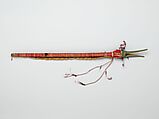Whistle
Not on view
This whistle has no finger holes, creating a limited tonal range and making it ideal for signaling. Today, the whistle's use varies with each community, but in the past a leader used it to direct Grass Dance singers to resume or cease their songs. Some dancers held these symbolic crane-headed whistles as they flattened the grass during their dance.
The sole opening in the shaft of the whistle is a duct window. Carved and hollowed from a single piece of wood and wrapped in red-dyed strips of reeds, this whistle features two braided lengths of sweetgrass lashed to its underside. Sweetgrass is considered sacred and used as a means of purification in many tribes. A collar of red-dyed, quilled spokeswith small rolled-metal cones and dyed down feathers surround the crane's beak. Two elongated tethers with feather adornment are attached at the collar's base.
Due to rights restrictions, this image cannot be enlarged, viewed at full screen, or downloaded.

